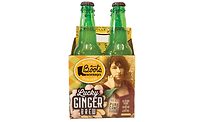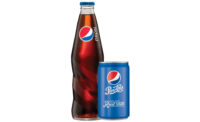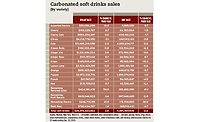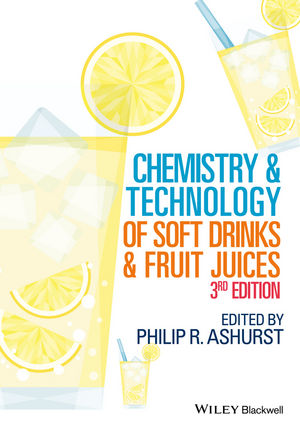The 2006 Soft Drinks Report
By ELIZABETH FUHRMAN
New flavors, rebranding and reformulation try to rejuvenate
carbonated soft drinks
Commitment to innovation, new flavors and healthier options emerged as
the driving forces behind brands that saw growth in the carbonated soft
drink category in 2005. Last year, volume was down for all three major soft
drink companies in measured U.S. retail channels. Category volume dropped
3.9 percent in combined retail channels, with Coca-Cola falling 4.2
percent, Pepsi-Cola sinking 4.7 percent and Cadbury Schweppes dipping 1.2
percent. Even flagship diet brands took a hit with Diet Coke’s volume
tumbling 5 percent overall and Diet Pepsi’s volume declining nearly
the same at 4.7 percent.
For the first time in two decades, the number of soda
cases sold in the United States declined. In 2005, case volume was down 0.7
percent to 10.2 billion cases.
Additionally negative media reports linked soft
drinks, even diet soft drinks, to causes for obesity and dental health
issues. As a result, soft drink developers created newly formulated
sugar-free alternatives, extended current lines with new flavor options,
refreshed stagnate brands with new packaging and branding, and purchased
healthful carbonated soft drink products to add to their offerings. While
the market for carbonated soft drinks has yet to turn around completely,
signs of success are visible in increased revenue for reinvigorated brands
in 2006.
Time for something new
Despite full-year declines, The Coca-Cola Co.’s total sales saw balanced unit case volume
growth in the fourth quarter last year, with carbonated soft drinks growing
2 percent, and its other categories growing much larger, such as 12 percent
for non-carbonated beverages (excluding water) and 17 percent for water.
Trademark Coca-Cola, Sprite and Fanta grew unit case volume by 2, 5 and 4
percent, respectively, in the quarter. For the
full year, both global sales of Coca-Cola and Sprite brands recorded their
highest growth rates in five years, Coca-Cola’s annual report says.
Coca-Cola’s net income fell 28 percent to $864
million during the last quarter of 2005, but the drop was not as bad as
analysts had expected. Fourth-quarter revenues grew 7 percent to $5.5
billion.
Coca-Cola’s full-year revenues rose 6 percent
during 2005, with a 4 percent increase in case volumes attributed to strong
sales in emerging markets such as China, Turkey, Brazil and Russia.
Full-year income was flat at $4.87 million.
For North America, Coca-Cola’s carbonated
beverages unit case volume increased more than 1 percent in the fourth
quarter, reversing negative trends through the first three quarters of
2005. Continued success of Coca-Cola Zero, which is now at 0.9 market
share, and Diet Coke Sweetened with Splenda led to improved trends on
Coca-Cola branded products in the quarter, according to its annual report.
In addition, the launch of new Fresca flavors contributed to unit case
volume and share growth in carbonated beverages during the quarter.
Diet Coke Sweetened with Splenda, launching in the
second quarter of 2005, started the year off for Coca-Cola’s new diet
offerings. Coca-Cola followed in June with Coca-Cola Zero, a new
zero-calorie cola that is sweetened with a blend of aspartame and
acesulfame potassium (ace-k). In a different kind of “diet”
offering, Coca-Cola released Coca-Cola Classic in an 8-ounce can with only
“100 calories per can” posted on the package.
Coca-Cola followed those launches with the
introduction of two new zero-calorie line extensions on the Fresca brand
and updated the packaging that re-released in September 2005. Fresca was
given a contemporary look, including a new logo and new packaging graphics.
Two new flavors — Sparkling Peach Citrus Fresca and Sparkling Black
Cherry Citrus Fresca — were introduced sweetened with aspartame and
ace-k. The sparkling citrus flavor of original Fresca remained unchanged.
With the success of Diet Coke with Lime, followed by
the introduced of Coca-Cola with Lime at the beginning of 2005, Coca-Cola
saw its lime-flavored soft drink market share increase nearly 42 percent.
But the company also watched its market share drop for Coke with Lemon,
Vanilla Coke and Diet Vanilla Coke. Vanilla Coke volume declined 43.2
percent and Vanilla Diet Coke volume dropped 38.7 percent. Diet Coke with
Lemon volume fell the most dramatically at 68.4 percent. In turn, Coca-Cola
phased out the lemon- and vanilla-flavored varieties at the end of 2005.
Countering the hiatus of the lemon and vanilla
flavors, Coke began 2006 with new carbonated soft drink launches of regular
and diet versions of Black Cherry Vanilla Coca-Cola early in the year. The
simultaneous launch of Diet Black Cherry Vanilla Coke and Black Cherry
Vanilla Coke was a first for Coca-Cola. Diet Cherry Coke and Cherry Coke,
which saw its market share slightly decrease last year, were not affected
by the introduction.
Coca-Cola also kept its new product introductions
going in 2006 with Vault, a hybrid energy soda. Vault’s national
launch in February followed its debut in select U.S. test markets last
fall. Vault features a citrus taste with less carbonation than most sodas
and similar ingredients as many energy drinks. Competitively priced with
traditional soft drinks on the market, Vault and Vault Zero — a
no-sugar version of the brand featuring aspartame and ace-k — are
available in traditional soft drink packaging such as 20-ounce and 1-liter
bottles, with more packaging, including 2-liter bottles and 12-ounce cans
to launch later this spring. The Vault launch is supported by an integrated
marketing campaign, featuring the tagline, “Drinks like a soda, Kicks
like an energy drink.”
“Vault helps take things to the next level by
combining attributes from traditional soft drinks and energy drinks to
provide young adults with the taste, refreshment and energy boost
they’re seeking,” said Stuart Kronauge, director of flavor
brands for Coca-Cola North America, in a release. “...Vault offers
the best of both worlds in one appealing package.”
According to bloggers on the Web site vaultkicks.org,
Vault has a similar taste and reminds consumers of Coca-Cola’s former
Surge product. But today, Vault is going head to head with
Pepsi-Cola’s MDX energy soda.
Firsts and relaunches
For the first time in their long, competitive history,
PepsiCo overtook Coca-Cola in terms of its market capitalization in
December. Coca-Cola fell slightly behind at $97.9 billion to
PepsiCo’s $98.4 billion — a change that industry experts
credited to PepsiCo’s policy of diversification and investment in new
health-conscious brands.
PepsiCo’s net revenues rose 11 percent during
2005, on the back of a 7 percent increase in volumes. The company’s
full-year figures were boosted by a strong fourth quarter that saw revenues
jump 15 percent and volumes grow 7 percent.
Volume at Pepsi Beverages North America grew 10
percent because of increases in Gatorade, Aquafina and Propel fitness
water. Sales of diet carbonated soft drinks rose slightly, offsetting a
slight decline in sales of regular soft drinks.
In 2005, Pepsi-Cola relaunched a number of brands,
including Pepsi One. The company added Splenda to the reformulated Pepsi
One, giving the beverage a full-flavor cola taste with one calorie. New
graphics of black and silver also helped to grab consumers’
attention.
Pepsi-Cola also released Mountain Dew Pitch Black II
for a 10-week period during the fall. The product is Mountain Dew with a
blast of black grape, and is packaged in a cool metallic silver label.
Pitch Black II is similar to 2004’s Pitch Black, but this time the
product has a sour bite. “Consumers loved
Mountain Dew Pitch Black and they wanted us to bring it back, but with
something new,” Pepsi-Cola North America said in a release.
“Sour flavors are big right now with teens and young adults, so we
added a sour bite to Mountain Dew Pitch Black II.”
Flavor additions continued to invigorate sales in
carbonated beverages for Pepsi-Cola. In May, the company released Pepsi
Lime and Diet Pepsi Lime, which is sweetened with aspartame and ace-k.
Pepsi-Cola launched Pepsi Lime and Diet Pepsi Lime together to give the
flavored-cola category a full measure of incremental growth, the company
said.
In August, Pepsi-Cola achieved another first in the
release of Frawg, an apple-flavored,
caffeinated soda that is available exclusively at 7-Eleven as a Slurpee and
a Big Gulp fountain drink. Targeted to teens and twenty-somethings,
Pepsi-Cola hopes to appeal to 7-Eleven’s savvy beverage consumers
looking for unique products that could not be found elsewhere.
After two years of product development, Frawg marks
several firsts: the first time a major soft drink company has created a new
brand specifically for a single retailer, the first time 7-Eleven has
introduced simultaneous flavors on both the Slurpee and fountain machine
and the first apple-flavored carbonated beverage from a major soft drink
company. 7-Eleven was given exclusive rights to Frawg for one year.
Last year, PepsiCo also brought the Tropicana brand
name to the carbonated soft drink category with the launch of Tropicana
Twister Soda. The soda contains 1 percent juice, and is available in
Orange, Diet Orange (sweetened with aspartame and ace-k), Strawberry and
Grape flavors in a 20-ounce plastic bottle. This year, the industry reports
that Pepsi-Cola will reintroduce Slice flavored soft drinks as Slice One, a
line of carbonated soft drink flavors, exclusively at Wal-Mart.
Pepsi-Cola rounded out its new releases for 2005 with
the launch of Mountain Dew MDX in November. MDX features the familiar
citrus flavor of Mountain Dew, but also includes ginseng, guarana, taurine
and d-ribose, helping to provide a higher level of energy than regular
soda. The launch of MDX also marked the debut of a new single-serve
14-ounce PET bottle. “MDX is the next logical step in our
evolution,” Pepsi-Cola said in a release. “Consumers are
increasingly looking for energy — witness the explosion of energy
drinks — there is great opportunity for an entirely new
category.”
With its quest to offer healthful options last year,
Pepsi-Cola North America, The Pepsi Bottling Group, PepsiAmericas, Pepsi
Bottling Ventures and other leading members of Pepsi’s bottling system declared their support for the American Beverage
Association’s new school vending policy. PepsiCo said it would work
closely with parents, community leaders and school officials to provide
only bottled water and 100 percent juice to elementary school students.
Additionally, PepsiCo said it would provide nutritious
and/or lower-calorie beverages to middle school students, such as bottled
water, 100 percent juice, sports drinks, no-calorie soft drinks and
low-calorie juice drinks. No full-calorie soft drinks or full-calorie juice
drinks with five percent or less juice will be provided until after school
hours. The company also said it will provide a variety of beverage choices
to high school students, including bottled water, 100 percent juice, sports
drink and juice drinks. No more than 50 percent of the vending selections
for high school students will be full-calorie soft drinks.
Following its strategy of offering healthy options in
every category, PepsiAmericas Inc. has purchased Ardea Beverage Co., maker
of Airforce Nutrisoda, and will collaborate with Pepsi-Cola North America
to market Airforce Nutrisoda in select markets, with the possibility for
future expansion. Ardea will operate as a wholly owned subsidiary of
PepsiAmericas.
The Ardea portfolio includes a line of nutritionally
enhanced, low-calorie, carbonated beverages. “The Nutrisoda brand
complements our growing portfolio of healthier beverages, providing a
unique and fashionable beverage alternative,” said Robert Pohlad,
chairman and chief executive officer of PepsiAmericas.
Nutrisoda targets on-the-go consumers who are
nutritionally aware. Each of the seven products within the portfolio
contains vitamins and minerals formulated to achieve a specific benefit.
The products have few or no carbs, sugar, sodium or calories. Brand
offerings include Immune in tangerine and lime flavor, Radiant in
pomegranate and black berry, Calm in wild berry and citron, Focus in mango
and peach, Flex in black cherry and apple, Energize in mandarin and mint,
and Slender in pink grapefruit and guava.
Age of marketing
During a year where Cadbury Schweppes sold its
European beverage business for $2.2 billion, the confectionery/beverage
company still made carbonated soft drinks a priority in 2005. Beverages
sales rose 6.2 percent, and Cadbury Schweppes said it increased its market
share in the United States to 17 percent, largely due to the introduction
of Cherry Vanilla Dr Pepper. The company’s beverage division
contributed to a 13 percent increase in underlying full-year profit to $1.5
billion.
“Our business in North America continued to reap
the benefits of consolidating three separately run businesses into
one,” the company said in a statement.
In November, Cadbury Schweppes sold its European
beverage business to Blackstone Group International and Lion Capital LLP.
Todd Stitzer, chief executive officer at Cadbury Schweppes said in a
statement that after the transaction the
company would be able to focus on its faster-growing confectionery and
other beverage businesses.
Then in February, The Wall
Street Journal printed financial experts’
opinions that Cadbury Schweppes seemed primed for a takeover. The Wall Street Journal’s “Heard
of the Street” column highlighted Hershey, Kraft and Nestlé as
possible bidders for the company. Cadbury Schweppes’ decision to sell
its European soft drinks business reignited talk that the company also
could shed its U.S. beverage brands, the paper reported. Stitzer though has
told analysts and investors in recent weeks that he has no plans to sell
the soft drinks business and expects that Cadbury Schweppes will remain
independent for the next several years.
The No. 3 soft drinks group in the United States
behind Coca-Cola and PepsiCo Inc., Cadbury Schweppes, like its
counterparts, benefited from flavored line extensions and advanced its
lines with reformulations. Cherry Vanilla Dr Pepper and its diet version,
which launched in 2004 in select markets and rolled out nationwide in 2005,
received a marketing push from Cadbury Schweppes in 2005, with special
events and tasting opportunities such as roller skating carhops passing out
samples.
“Dr Pepper had a tremendous growth year last
year really fueled by our innovation around Cherry Vanilla and Diet Cherry
Vanilla,” says Jim Trebilcock, senior vice president of marketing at Cadbury Schweppes. “But that brand
continues to perform well on regular, diet and with our innovation, and we
look to continue to develop that trademark aggressively this year, along
with our bottling partners.”
Cherry Vanilla Dr Pepper and the diet version will be
a permanent part of the Dr Pepper line up, Trebilcock says.
“We’re investing more this year in Cherry Vanilla and Diet
Cherry Vanilla then we did last year,” he adds. “We believe we
can grow the brand in year two, and not fall into the trap of year two
brands that typically fall off, because the repeat purchase on it is so
strong.”
Already beginning its marketing push, in February
Cadbury Schweppes conducted the Diet Dr Pepper National Sampling Blitz,
blanketing the country with more than 250 million free full-size cans,
fountain drinks and other giveaways. Free product samples and coupons were
distributed through traditional retail partners and high-profile events,
including a free Diet Dr Pepper Fountain Day at 7-Eleven stores and special
promotions through Target and Wal-Mart







